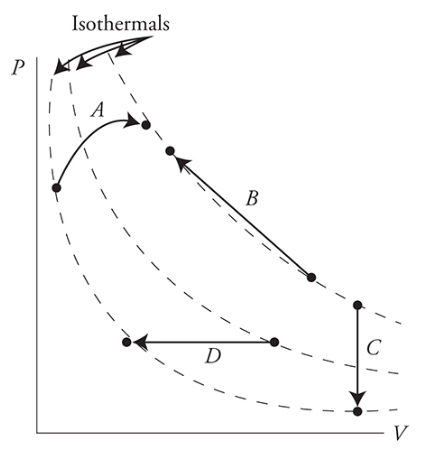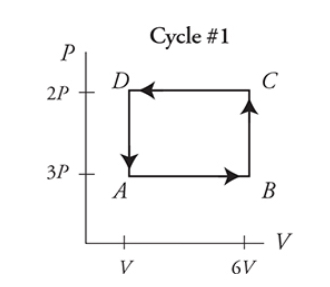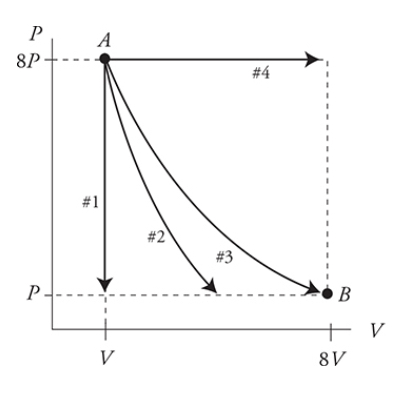
Chapter 2 - Thermodynamics and Gases
Atomic Behavior
The temperature of an object indicates the speed at which the molecules are vibrating
Hot objects = higher speed
Cold objects = slower speed
Temperature is a direct measure of average kinetic energy
In general, hot objects expand and cold objects shrink a little bit
The motion of atoms follows a pattern that is shown in graphs of the number of atoms vs average kinetic energy as a normal curve
Hot temperatures have a lower peak that’s shifted to the right but has the same area under the curve
Cold temperatures have a higher peak that’s shifted to the left but has the same area under the curve
This means that it’s possible for some cold atoms to have greater kinetic energy than hot atoms but on average, hot atoms have more kinetic energy
Thermal energy moves from hot to cold
This is because hot molecules tend to collide with cold molecules which result in a net transfer of kinetic energy to the cold molecule
Remember, this is still on average - exceptions do occur
For objects at the same temperature, there is still an energy exchange between them but the net transfer is 0
We call this thermal equilibrium
Heat, Temperature, and Power
Heat (Q) - a type of energy that can be transferred between objects
Measured in Joules
Heat vs. Internal Energy
Heat is transferred not possessed - 10 J of heat was transferred to the second box
Internal energy is possessed - The box has 10 J of internal energy
Internal Energy (U): The sum of the energies of all molecules in a substance
Temperature (T): Related to average kinetic energy
Measured in Kelvins or Degrees Celsius
Kelvin = Celsius + 273
Two bodies at the same temperature don’t always have the same internal energy
A bigger object of the same material and temperature will have more internal energy than a smaller object
Power: Work per time
Measured in Joules per second (same thing as Watts)
Heat Transfer
There are 3 physical methods of heat transfer
Conduction: the transfer of energy from vibrations from atom to atom of an object from the hotter side to the colder side
In other words, when 2 objects are touching, the transfer of energy from the hot to the cold object until they’re in thermal equilibrium
Factors that can affect the rate of this heat transfer:
Thermal conductivity (k) of the material
Metals are better conductors and have a higher thermal conductivity as compared to something like a piece of wood
The difference in temperatures of the two objects
A greater temperature difference will cause a faster rate of heat transfer
The cross-sectional area of the object the heat is transferred through
A larger cross-sectional area will cause a faster rate of heat transfer
The length of the material the heat is transferred through
A longer object will cause a slower rate of heat transfer
These factors combine to form the equation for the rate of heat transfer:
ΔQ/t = kAΔT/L
ΔQ/t = rate of heat transfer (J/s)
k = thermal conductivity
A = cross-sectional area (m^2)
ΔT = temperature difference (K)
L = length (m)
Convection: the transfer of thermal energy through fluid flow
Because hotter objects expand, fluids are less dense and naturally rise because their volume is bigger but their mass is the same
Radiation: transfer of energy through electromagnetic waves
The vibration of charged particles (protons and electrons) creates electromagnetic waves
These waves carry energy away from the object
Kinetic Theory of Gases
The Kinetic Theory of Gases assumes for ideal gases:
Molecules move continuously and randomly
There is a large number of gas molecules in a container
Molecules don’t exert electrical or gravitational forces on each other
All collisions between molecules are elastic
In elastic collisions, kinetic energy is not lost
The Kinetic Theory of Gases derives the following equations:
U = 3/2 nRT = 3/2 NkT
U - internal energy
R - Ideal gas constant - on equation sheet
k - Boltzmann’s constant - given on the equation sheet
T - temperature
Relates the internal energy of a gas to its temperature
v = sqrt((3kT)/(m))
v - velocity of a gas
m - mass
k - Boltzmann’s constant - given on the equation sheet
Ideal Gas Law
PV = nRT
P - pressure (Pascal - Newton per meter squared)
V - volume of the gas (cubic meters)
n - number of moles of gas
R - ideal gas constant
T - temperature (K)
PV = NkT
N - number of molecules
k - Boltzmann’s constant - given on equation sheet
In times when the number of moles are constant, PV/T is also held constant
Use this formula for calculations
Graphical Analysis
When graphing pressure versus temperature, the temperature at which pressure is 0 is called absolute zero
Zero volume of gas will occur at absolute zero if we plot volume as a function of temperature
First Law of Thermodynamics
First Law of Thermodynamics: The internal energy of a system is conserved
ΔU = Q + W
ΔU - internal energy
Q - heat added to the gas
If heat is added, sign of Q is positive
W - work done on the gas
If the gas is compressed, work is done on the gas and W is positive
If the gas is expanded, work is done by the gas and W is negative
Remember that Work = Force x distance
PV Diagrams
PV Diagrams - graphs of pressure on the y-axis and volume on the x-axis
Isothermal lines - a line in which every point that has the same PV value (and therefore the same T)
Work = -PΔV
Moving to the right on a PV graph is negative work and vice versa
Area under the curve of the graph is equal to magnitude of work
To find ΔT, compare the PV path to isothermal lines or see if P or V changed

To find ΔU, find ΔT because ΔU = 3/2 nRΔT
To find Q, use ΔU = Q + W where Q and W are already given or are found from area under the graph and/or ΔT
Cycles on a PV diagram

Cycles: paths on the PV diagram that start and end at the same point
Same PV value at the start and end → ΔT is 0 → ΔU is 0 → Q = -w (remember the first law of thermodynamics)
Work becomes the area contained in the shape created by the cycle
Four Special Processes (Paths)


Constant Pressure - Isobaric
Horizontal lines on the PV graph
Constant Volume - Isochoric (Isovolumetric)
Vertical lines on PV graph
Constant Temperature - Isothermal
Hyperbolic constant lines on the PV graph
Less steep than Adiabatic processes
Q = -W
No Heat Transfer Between System and Environment - Adiabatic
Curved path but steeper than Isothermal process
Entropy
Entropy: a measure of disorder
Second Law of Thermodynamics: The entropy of a system cannot decrease unless work is done on that system
Think of a glass: when broken, work must be done to put it back together in a more orderly state
The universe has a tendency towards entropy
When heat flows into a system, entropy increases
Chapter 2 - Thermodynamics and Gases
Atomic Behavior
The temperature of an object indicates the speed at which the molecules are vibrating
Hot objects = higher speed
Cold objects = slower speed
Temperature is a direct measure of average kinetic energy
In general, hot objects expand and cold objects shrink a little bit
The motion of atoms follows a pattern that is shown in graphs of the number of atoms vs average kinetic energy as a normal curve
Hot temperatures have a lower peak that’s shifted to the right but has the same area under the curve
Cold temperatures have a higher peak that’s shifted to the left but has the same area under the curve
This means that it’s possible for some cold atoms to have greater kinetic energy than hot atoms but on average, hot atoms have more kinetic energy
Thermal energy moves from hot to cold
This is because hot molecules tend to collide with cold molecules which result in a net transfer of kinetic energy to the cold molecule
Remember, this is still on average - exceptions do occur
For objects at the same temperature, there is still an energy exchange between them but the net transfer is 0
We call this thermal equilibrium
Heat, Temperature, and Power
Heat (Q) - a type of energy that can be transferred between objects
Measured in Joules
Heat vs. Internal Energy
Heat is transferred not possessed - 10 J of heat was transferred to the second box
Internal energy is possessed - The box has 10 J of internal energy
Internal Energy (U): The sum of the energies of all molecules in a substance
Temperature (T): Related to average kinetic energy
Measured in Kelvins or Degrees Celsius
Kelvin = Celsius + 273
Two bodies at the same temperature don’t always have the same internal energy
A bigger object of the same material and temperature will have more internal energy than a smaller object
Power: Work per time
Measured in Joules per second (same thing as Watts)
Heat Transfer
There are 3 physical methods of heat transfer
Conduction: the transfer of energy from vibrations from atom to atom of an object from the hotter side to the colder side
In other words, when 2 objects are touching, the transfer of energy from the hot to the cold object until they’re in thermal equilibrium
Factors that can affect the rate of this heat transfer:
Thermal conductivity (k) of the material
Metals are better conductors and have a higher thermal conductivity as compared to something like a piece of wood
The difference in temperatures of the two objects
A greater temperature difference will cause a faster rate of heat transfer
The cross-sectional area of the object the heat is transferred through
A larger cross-sectional area will cause a faster rate of heat transfer
The length of the material the heat is transferred through
A longer object will cause a slower rate of heat transfer
These factors combine to form the equation for the rate of heat transfer:
ΔQ/t = kAΔT/L
ΔQ/t = rate of heat transfer (J/s)
k = thermal conductivity
A = cross-sectional area (m^2)
ΔT = temperature difference (K)
L = length (m)
Convection: the transfer of thermal energy through fluid flow
Because hotter objects expand, fluids are less dense and naturally rise because their volume is bigger but their mass is the same
Radiation: transfer of energy through electromagnetic waves
The vibration of charged particles (protons and electrons) creates electromagnetic waves
These waves carry energy away from the object
Kinetic Theory of Gases
The Kinetic Theory of Gases assumes for ideal gases:
Molecules move continuously and randomly
There is a large number of gas molecules in a container
Molecules don’t exert electrical or gravitational forces on each other
All collisions between molecules are elastic
In elastic collisions, kinetic energy is not lost
The Kinetic Theory of Gases derives the following equations:
U = 3/2 nRT = 3/2 NkT
U - internal energy
R - Ideal gas constant - on equation sheet
k - Boltzmann’s constant - given on the equation sheet
T - temperature
Relates the internal energy of a gas to its temperature
v = sqrt((3kT)/(m))
v - velocity of a gas
m - mass
k - Boltzmann’s constant - given on the equation sheet
Ideal Gas Law
PV = nRT
P - pressure (Pascal - Newton per meter squared)
V - volume of the gas (cubic meters)
n - number of moles of gas
R - ideal gas constant
T - temperature (K)
PV = NkT
N - number of molecules
k - Boltzmann’s constant - given on equation sheet
In times when the number of moles are constant, PV/T is also held constant
Use this formula for calculations
Graphical Analysis
When graphing pressure versus temperature, the temperature at which pressure is 0 is called absolute zero
Zero volume of gas will occur at absolute zero if we plot volume as a function of temperature
First Law of Thermodynamics
First Law of Thermodynamics: The internal energy of a system is conserved
ΔU = Q + W
ΔU - internal energy
Q - heat added to the gas
If heat is added, sign of Q is positive
W - work done on the gas
If the gas is compressed, work is done on the gas and W is positive
If the gas is expanded, work is done by the gas and W is negative
Remember that Work = Force x distance
PV Diagrams
PV Diagrams - graphs of pressure on the y-axis and volume on the x-axis
Isothermal lines - a line in which every point that has the same PV value (and therefore the same T)
Work = -PΔV
Moving to the right on a PV graph is negative work and vice versa
Area under the curve of the graph is equal to magnitude of work
To find ΔT, compare the PV path to isothermal lines or see if P or V changed

To find ΔU, find ΔT because ΔU = 3/2 nRΔT
To find Q, use ΔU = Q + W where Q and W are already given or are found from area under the graph and/or ΔT
Cycles on a PV diagram

Cycles: paths on the PV diagram that start and end at the same point
Same PV value at the start and end → ΔT is 0 → ΔU is 0 → Q = -w (remember the first law of thermodynamics)
Work becomes the area contained in the shape created by the cycle
Four Special Processes (Paths)


Constant Pressure - Isobaric
Horizontal lines on the PV graph
Constant Volume - Isochoric (Isovolumetric)
Vertical lines on PV graph
Constant Temperature - Isothermal
Hyperbolic constant lines on the PV graph
Less steep than Adiabatic processes
Q = -W
No Heat Transfer Between System and Environment - Adiabatic
Curved path but steeper than Isothermal process
Entropy
Entropy: a measure of disorder
Second Law of Thermodynamics: The entropy of a system cannot decrease unless work is done on that system
Think of a glass: when broken, work must be done to put it back together in a more orderly state
The universe has a tendency towards entropy
When heat flows into a system, entropy increases
 Knowt
Knowt
